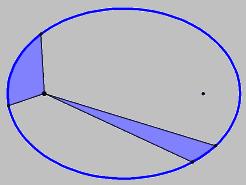
Home
Rocketry
Orbits
Gravity
Kepler's Laws
Orbital Elements
Types of Orbits
Orbit Transfers
Going to the Moon
Technology
Kepler's Laws
Johannes Kepler made three statements that really impacted the physics of planetary motion, which is directly linked to satellite motion.
- The orbit for each planet is an ellipse with the sun at one focus.
- The line from the sun to a planet sweeps out equal areas inside the ellipse in equal lengths of time.
- The squares of the orbital periods of the planets are proportional to the cubes of their mean distance from the sun.
The first statement can be extrapolated to include any satellite orbiting a massive body, such as moon-earth, ISS-earth, earth-sun.

The second statement can be understood more by looking at this picture. When the satellite is far from the planet, it move more slowly (less degrees per second) but has a much larger radius; and when the satellite is close to the planet it move a lot faster (more degrees per second) but has a smaller radius. These two variables are in balance and cancel out each others changes in swept out area.
The third statement implies that if we square the period of a planet, it will be proportional to the number obtained from cubing the semi-major axis.
